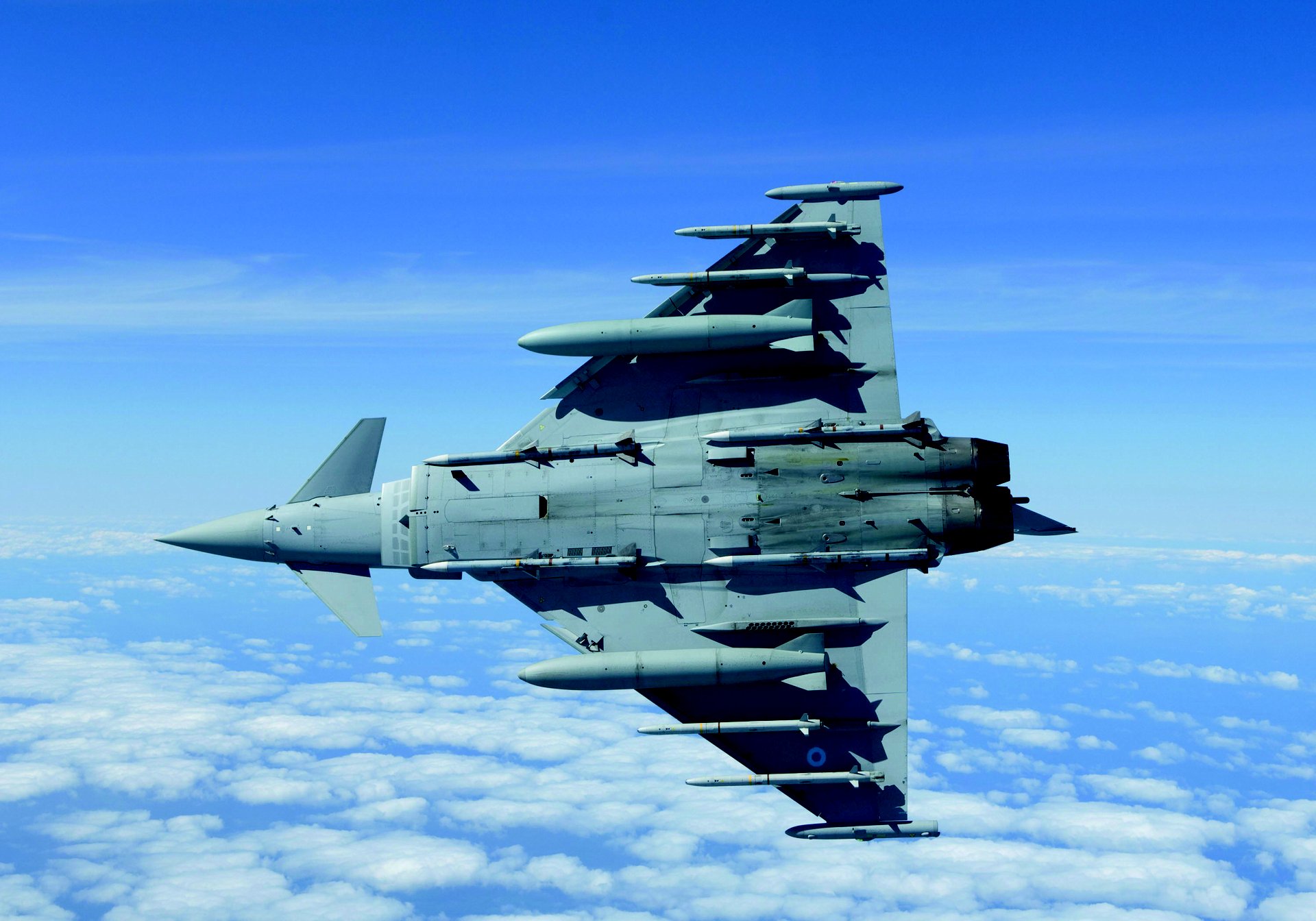Four RAF Typhoon FGR4s, backed by a Voyager air refueling tanker, used Paveway IV-guided bombs to conduct precision strikes on Houthi rebels. A number of buildings involved in drone operations were targeted by RAF jets, according to UK MoD.
The other location struck by Typhoons was the airfield at Abbs. Intelligence has shown that it has been used to launch both cruise missiles and drones over the Red Sea. Several key targets at the airfield were identified and bombed by RAF fighters.
British PM Rishi Sunak confirmed the development and said the Royal Air Force participated in the attacks on “facilities used by Houthi rebels in Yemen.” “The United Kingdom will always stand up for freedom of navigation and the free flow of trade,” Sunak said.
“We have therefore taken limited, necessary, and proportionate action in self-defense, alongside the United States with non-operational support from the Netherlands, Canada, and Bahrain against targets tied to these attacks, to degrade Houthi military capabilities and protect global shipping.”
US President Joe Biden said he ordered the strikes “in direct response to unprecedented Houthi attacks against international maritime vessels in the Red Sea.”
“Today, at my direction, US military forces—together with the United Kingdom and with support from Australia, Bahrain, Canada, and the Netherlands—successfully conducted strikes against a number of targets in Yemen used by Houthi rebels to endanger freedom of navigation in one of the world’s most vital waterways,” the president said in a statement released by the White House.
Meanwhile, a Houthi official has confirmed on X, formerly Twitter, that attacks have been carried out throughout Yemen. “American-Zionist-British aggression against Yemen launches several raids on the capital, Sanaa, Hudaydah governorate, Saada, and Dhamar,” Houthi official Abdul Qader al-Mortada posted.

RED Alert In RED Sea
John Bolton, former US ambassador to the UN and US National Security advisor, noted that the evidence about Iran striking a chemical tanker in the Indian Ocean with a drone is of huge importance, as it should command the next move of Washington and London.
In a comment piece for the Daily Telegraph on December 25, he wrote, “Obviously, Tehran does not feel pressured enough to restrain its expendable surrogates, proving that the West has not established conditions for deterrence, thereby potentially cooling this conflict down.”
Bolton argues that Tehran has miscalculated not only about Israel but about President Biden and the West more generally.
Terrorising Red Sea
A BBC news bulletin of 25 December reported that a chemical tanker in the Indian Ocean was hit by a drone launched from Iran on Saturday, the US military says.
A fire on board the Chem Pluto was extinguished. There were no casualties. Houthi rebels in Yemen, who are backed by Iran and support Hamas in its war with Israel, have recently used drones and rockets to target vessels in the Red Sea.
Ambrey, a maritime security firm, said that the chemical/products tanker was Israel-affiliated and had been on its way from Saudi Arabia to India. The Indian Navy responded to a request for assistance and dispatched an aircraft that established the safety of the involved ship and its crew.
Last month, an Israeli-owned cargo ship was hit by a suspected drone attack by Iran’s Islamic Revolutionary Guard Corps in the Indian Ocean, according to a US official.
In recent weeks Yemeni Houthi have also been terrorising the Red Sea and threatening the global economy by attacking commercial shipping vessels taking, so far, 25 crew members of an Israeli-linked cargo hostage.
Accusations
On December 23, the Pentagon accused Iran of launching a “one-way drone” attack on the Liberian–flagged, Japanese–owned, and Netherlands-operated chemical tanker. The Yemeni groups are linked to Tehran, which provides them with economic support as well as advanced weapons and military technology “Through these alliances, Iran, Iran leads a conflict by proxy aimed at weakening Western presence in the Middle East and harming Israel.
In its issue of December 23, The Wall Street Journal columnist Benoit Falcon stated that Iran’s paramilitary forces are providing real-time intelligence and weaponry, including drones and missiles, to Yemen’s Houthi that the rebels are using to target ships passing through the Red Sea.
Iran-backed Houthi forces in Yemen claimed responsibility for the attacks, and the Pentagon warned of a potential US response. In a news bulletin of Friday, 22 December, CNN quoted National Security Council spokesperson Adrienne Watson saying that the US had released newly classified intelligence that suggests Iran has been “deeply involved in planning the operations against commercial vessels in the Red Sea.”
According to the same source, the Iran-backed Houthi rebels have launched more than 100 attacks against about a dozen commercial and merchant ships transiting the Red Sea over the past four weeks. The newly declassified intelligence suggests that “Iranian support throughout the Gaza crisis has enabled the Houthi to launch attacks against Israel and maritime targets, though Iran has often deferred operational decision-making authority to the Houthi,” Watson said.
The intelligence also suggests that the Iranians have provided monitoring systems to the Houthi that allow them to operate in the maritime space. Iran has provided tactical intelligence to the Houthi, which is of critical importance for targeting maritime vessels. Watson added that Iran has been providing the Houthi the drones and missiles since the group commenced attacks in November.”
Stakeholders React
Biden has said that he does not like an extension of hostilities, but at the same time, preparations are afoot to deal with the Houthi menace in the crucial region of the Red Sea and the Mediterranean.
A senior military officer said that the “very significant breadth of attacks on commercial ships in the Red Sea has escalated to a level not seen at least in two generations.” Last week, the US launched Operation Prosperity Guardian, a maritime coalition aimed at beefing up security in the southern Red Sea. More than 20 nations have signed on to the initiative so far, informed the Pentagon.
The Chum Pluto vessel carrying chemicals is said to have originated somewhere on the West coast of India. The vessel’s movements have been monitored by Iran via Houthi. Previously also, Houthi had become a source of nuisance.
Based on a report originating with the Hindustan Times of 19 December, we conclude that while the US has unveiled a multinational naval force to protect merchant vessels in the Red Sea from Iranian-backed Houthi militia, India has stationed two guided-missile destroyers off the coast of Aden as part of maritime security in the north Arabian Sea.
Indian Navy’s Destroyer In The Gulf of Aden
Even though the government remains tight-lipped about the development, the Indian Navy destroyer INS Kochi is involved in mitigating merchants’ vessels against Somali pirates on the coast of the Red Sea. India has also sent another guided missile stealth destroyer INS Kolkata to muscle up maritime security off the coast of Aden.
On Monday, the US announced Operation Prosperity Guardian to protect sea-borne traffic in the Red Sea from ballistic missile and drone attacks launched by Shia Houthi groups in Yemen. The coalition includes countries like the UK, Bahrain, France, Norway and other countries.
The Iran-backed Houthi militia, which is fighting the Government of Yemen, with support from terrorist groups like Al Qaeda in the Arabian Peninsula, Islamic State, and the Anwar Al-Shari, has virtually become a state actor with an arsenal of helicopters, ballistic missiles, and missile-firing drones.
Based in South Yemen near the Babb el-Man dab Red Sea choke-point, the Houthi militia is targeting commercial vessels as part of a plan to pressure the international community to stop Israel from military operations in Gaza.
Conclusion
The Houthi have emerged as a major military force in the Arabian Peninsula, with tens of thousands of fighters and a huge arsenal of ballistic missiles and armed drones.
Senior sources in the Iran-aligned camp told Reuters the Houthi attacks were part of an effort to put pressure on Washington to get Israel to halt the Gaza offensive, a goal that Iran shares with Saudi Arabia and other countries in the region.
Leading global shippers like Maersk said all its vessels bound for the Red Sea are being re-routed for safety reasons. Taking the extensive route around Africa means delays in cargo deliveries and pressure on freight weights. Oil prices will witness a substantial rise.
Iran, the real actor behind the Houthi proxy, has to understand that the entire world has stakes in the security and stability of the region. As such, the world will not accept being bullied the way Tehran has adopted.
Iran cannot go against the global interest of a safe and peaceful Red Sea region. About twenty countries in the world have supported the US Operation Prosperity Guardian plan. Iran should opt to be accepted as a member of the forum and cooperate to resolve the friction.
- KN Pandita (Padma Shri) is the former director of the Center of Central Asian Studies at Kashmir University. Views Personal.
- Follow EurAsian Times on Google News




